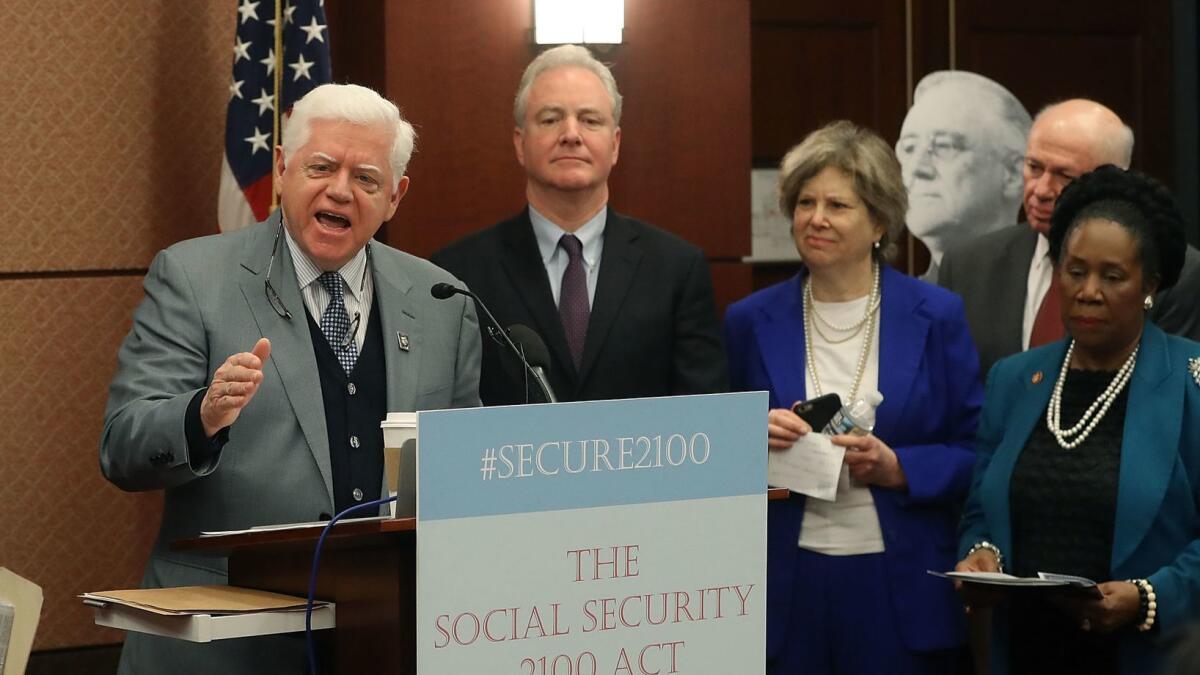Column: Surprise! Social Security has gotten healthier

The crux of the conservative attack on Social Security in recent years has been the claim that the program is on an unbroken path to insolvency. Mondayâs release of the Social Security trusteesâ annual report knocks a pillar out from under that campaign, for it shows that the program actually got healthier during the last year.
The trustees predicted that the programâs reserves â that is, the trust funds of its retirement and disability components â will be exhausted in 2035. In last yearâs report, the trustees pegged that date at 2034. In other words, the trust fundsâ exhaustion last year was 16 years away; this year itâs still 16 years away.
To use a different metric, the cost of making Social Security perfectly solvent has come down. Last year, the trustees projected that it would require an immediate increase in the payroll tax of nearly 2.8 percentage points, bringing the tax to 15.18% (shared by employers and employees), up from the current 12.4%; this year that estimate came down to 2.7 percentage points, bringing the required payroll tax rate to 15.1%.
Contrary to conservative propaganda, Social Security is not âgoing bankruptâ or âin peril.â
— Max Richtman, National Committee to Preserve Social Security and Medicare
The trustees also revised their near-term expectations. Last yearâs report, which was based on 2017 statistics, warned that the system would be paying out in benefits more than it took in starting in 2018. The shortfall was projected to be more than $1 billion of the annual program budget of about $1 trillion, and would mount steadily into the limitless future, unless changes were made in benefits or taxes. This yearâs report says the program actually was in the black last year, by more than $3 billion, and wonât have to start drawing down its reserves until 2020.
The trustees are Treasury Secretary Steven T. Mnuchin, Labor Secretary Alexander Acosta, Health and Human Services Secretary Alex Azar, and acting Social Security Commissioner Nancy Berryhill, all of whom serve ex officio. Two seats for appointed public trustees are vacant.
Weâll get to the main reason for the improvement in a moment. But the bottom line is positive. âThis yearâs trustees report shows that, contrary to conservative propaganda, Social Security is not âgoing bankruptâ or âin peril,ââ Max Richtman, head of the National Committee to Preserve Social Security and Medicare, said after the reportâs release.
These are incremental improvements, to be sure. But they underscore an important point: Social Securityâs fiscal condition is dynamic. Itâs dependent on a host of interrelated economic and demographic factors, many of which are fundamentally unpredictable even a few years into the future, much less 16 years. Pundits who tell you they know whatâs going to happen are blowing smoke.
Thatâs an argument for being very cautious about imposing irreversible costs on Social Security beneficiaries now in the name of protecting the program from expenses later. Thereâs no legitimate rationale for cutting benefits today because the program might be unable to pay 100% of scheduled benefits in 2035; much better to wait and see.
On the other hand, there are legitimate reasons to expand Social Security to make it more relevant to and useful for todayâs working Americans. Two Democratic measures to do so are on the table in Congress. Theyâre the Social Security 2100 Act, introduced by Rep. John B. Larson (D-Conn.), and the Social Security Expansion Act, filed by Sen. Bernie Sanders (I-Vt.), a candidate for president, and Rep. Peter A. DeFazio (D-Ore).
Both bills would strengthen Social Security by increasing the payroll tax on the wealthy, who get away with paying an unwarranted low tax rate. The payroll tax covers only wage income up to a cap ($132,900 this year); the bills would remove the cap over time; Larsonâs bill also would incrementally increase the tax rate.
Both would increase Social Security benefits, especially for lower-income workers. And they would enhance annual cost-of-living increases by tying them to an inflation index that better reflects the living costs experienced by seniors than the currently used consumer price index for urban workers.
That brings us to why the programâs fiscal status improved. The chief reason is that disability claims and awards have fallen sharply, and more than anticipated. Consequently, the disability insurance trust fundâs exhaustion date has been moved to 2052 from 2032 in last yearâs trusteesâ report.
The trustees observe that âdisability applications have been declining steadily since 2010, and the total number of disabled-worker beneficiaries in current payment status has been falling since 2014.â Theyâve now incorporated those trends in their projections. Thatâs a major recalculation, but the trend has been obvious to experts for years.
The reality hasnât stopped conservatives from demonizing the disability program, however. In 2017, Mick Mulvaney, President Trumpâs director of the Office of Management and Budget, took a totally uninformed swipe at disability recipients on the CBS news program âFace the Nationâ while its host, John Dickerson, sat mutely by.
Mulvaney called disability the fastest-growing program, which was absolutely wrong â it was shrinking by then. But Mulvaney was in good Republican company. These attacks were abetted by inept and inaccurate reporting by NPR, the Wall Street Journal and âFace the Nationâsâ sister CBS program, â60 Minutes,â which all posited nefarious causes for the pre-2010 rise in disability cases â malingering by claimants, corruption by officials and overly tolerant standards â all of which either had an insignificant effect on the caseload or were just false.
Keep up to date with Michael Hiltzik. Follow @hiltzikm on Twitter, see his Facebook page, or email [email protected].
Return to Michael Hiltzikâs blog.
More to Read
Inside the business of entertainment
The Wide Shot brings you news, analysis and insights on everything from streaming wars to production â and what it all means for the future.
You may occasionally receive promotional content from the Los Angeles Times.











